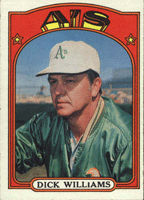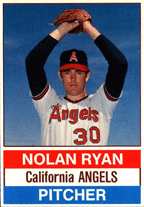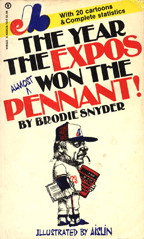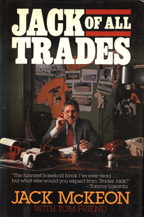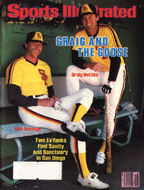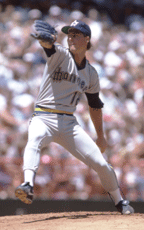|
|
|
| |
 |
|
| |
|
| |

The 1972
season would deliver the championship that Dick, Finley and
the A's were looking for, although not without a set of fights
that filled the Oakland clubhouse with angry noise and the
sports pages with lively reportage: Blue vs. pitcher Blue
Moon Odom, Jackson vs. first baseman Mike Epstein, Epstein
vs. Dick, etc. The Brawling A's became a legend, underscoring
the idea that a team didn't have to get along to go the distance.
Oakland
got to the World Series even though Dick had to indulge one
of Finley's less-than-brilliant ideas. In light of second
baseman Dick Green's injury, plus his weak bat when he was
available, Finley insisted they try an innovation: pinch-hit
for the second baseman every time through the line-up. That
way, Finley thought, it wouldn't matter that none of them
could hit. Not only did this burn up bench players, it forced
the skipper to use non-middle infielders when he ran out of
real second basemen. Everyone got pressed into service at
second, including catchers Larry Haney and Gene Tenace, third
baseman Sal Bando and outfielder Curt Blefary, who was nicknamed
"Clank" for his horrendous fielding rather than
his heavy hitting.
Finley,
however, does deserve some credit for his efforts in 1972.
He executed an unusually high 62 major league roster transactions,
hoping to arm his club with a range of valuable options. He
also paid players and coaches to grow mustaches, not only
to defuse a potential grooming issue, but to market a unique
image.
The A's
won 93 games and were as balanced in their play on the field
as they seemed imbalanced in their conduct off it. The team
finished second in the league in runs scored (604), second
in runs allowed (457), and second in defense (.732 defensive
efficiency rate).
Oakland
defeated the Tigers in a five-game playoff series and faced
Cincinnati's Big Red Machine in the World Series. The Reds
were as balanced as the A's (also second in runs scored, second
in runs allowed, and second in defensive efficiency). Unlike
the A's, they featured tidy haircuts and clean-shaven faces.
Oakland
had already suffered a huge loss when number-three hitter
and center fielder Reggie Jackson went down ith a hamstring
injury. Then odd events followed the A's into the Series.
With death threats against Oakland players made by Cincinnati
fans being taken seriously, an unclaimed suitcase was found
among the team's possessions. When no one claimed it, security
feared it might be a bomb, gingerly took it out to the deserted
field and carefully shot it open. It was filled to its scuppers
with Finley's shoes.
In the
series, Dick pulled off a range of extraordinary managerial
moves. Against baseball tradition, he bypassed veterans with
playoff experience and used young George Hendrick to replace
Jackson in center. At catcher, he went counter to the "one
that got you there" practice of sticking with his most
frequent starters and decided to go with back-up Gene Tenace
instead of Dave Duncan, who had hit 19 homers. Dick's rationale?
On a team with four other homer hitters, a fifth didn't make
as much difference.
Tenace
opened the scoring with a two-run homer in the second inning
of Game 1 and later delivered the game-winning hit, another
homer, in the fifth. In Game 2, with a 2-0 lead in the sixth,
Dick put in defensive replacement Mike Hegan at first for
slugger Mike Epstein. Hegan made a game-saving play in the
bottom of the ninth by spearing a César Gerónimo
liner that would have gone for extra bases.
In Game
3, Dick executed a trick he had learned from his childhood
team's manager, Billy Southworth. With Bobby Tolan on first
and Johnny Bench at the plate, Tolan stole second on a 2-1
count. When Rollie Fingers threw a strike to run the count
full, Dick went to the mound and appeared to chew out his
reliever for giving Bench something good to hit. In reality,
Dick instructed Fingers and Tenace to pretend they were going
to issue an intentional walk. Bench fell for it, and then
watched helplessly as Fingers fanned him with a strike on
the outside corner.
Behind
2-1 in the bottom of the ninth in Game 4, Dick called for
three consecutive pinch-hitters (Gonzalo Márquez, Don
Mincher, and Angel Mangual) and each delivered a hit to help
win the game. In the eighth inning of Game 7, Oakland was
up 3-1 with runners on second and third and one out. Dick
had Fingers intentionally walk the cold Bench to load the
bases for the hot Tony Perez, putting the go-ahead run on
base. But he also set up a force-out or double play. This
belied standard baseball dogma, but the strategem succeeded.
For the
1972 World Series, every move Dick made turned to gold (and
green). His dream of unquestionable, documented success—that
even his father would have found exhilarating—was a
tonic.
In 1973,
relations between Dick and the intrusive Finley worsened.
Dick, paid to be Finley's advocate with the players and the
players' advocate with Finley, found playing go-between increasingly
challenging, mostly because of the owner's conduct.
At 94-68,
the A's led the league in runs scored per game, and ranked
second in runs allowed and defensive efficiency. Oakland made
it back to the World Series and beat the New York Mets, but
not until Finley had poisoned the pleasure. After second baseman
Mike Andrews made two costly errors in Game 2, Finley humiliated
Andrews by forcing him to sign a false affidavit declaring
he was injured. That enabled Finley to replace him on the
series roster with a personal favorite. Dick explained his
employer's decision to the media, but at the same time, prompted
by his sense of integrity, made it clear that he didn't agree
with it. In that moment, he realized his position was untenable,
that he would have to resign. In a clubhouse meeting he called
before Game 3, Dick told his players he had set a new record
for a Finley manager (three full seasons). After the series,
however, he was moving on, even though he was signed to a
contract for another year.
For six
years—the three under Dick and the three following—Oakland
was almost a dynasty. Some of the players believe Dick was
the element that made them so successful. Blue, for example,
on hearing his manager had been elected to the Hall of Fame
said, "He's always joking about how he rode our coattails,
but he's the one who taught us to play winning baseball. Dick
Williams was that X-factor."
Odom was
also impressed. "With Dick, you had to give 100 percent
all the time," he said. "I had no problem with that,
and with him as manager, we felt no one could beat us."
Dick wasn't
particularly worried about leaving Oakland. In fact, he was
confident the he had a back-up plan—a close-to-tampering
September offer he had received from the new ownership group
of the New York Yankees. But that did not work out, thanks
to Finley.
The Oakland
owner knew his manager's contract had value, and, as always,
he never let an opportunity to make money go by. Precedent
made clear that Finley was entitled to cash or prospects or
a player from New York. He demanded both the Yankees' most
promising young everyday player, outfielder Otto Velez, and
their most promising young pitcher, Scott McGregor. It was
an unacceptable price, and one Dick knew was doomed to quash
the deal.
Within
a few weeks, John D. MacArthur, a multimillionaire philanthropist
who valued excellence in all realms, literally knocked on
the Williams's door unannounced and offered Dick a job, with
a raise over his baseball salary. Dick worked with MacArthur
for six months, until a baseball offer came that Finley would
accept, from a team Finley was confident would be no danger
to the Athletics' hegemony.
In June,
Dick was recruited by California Angels general manager Harry
Dalton, at the insistence of team owner Gene Autry. This was
not the free-spending Autry of the free-agency era—this
was the 13-year owner of a major-market team, a man who Dick
believed tried to get talent on the cheap, and who delivered
teams that were middling at best. In the previous seven seasons,
the Angels had finished at or above .500 only once, 86-76
in 1970, which was good enough for 3rd place in a six-team
division.
Dick wasn't
impressed by Autry's style. "They lost simply because
the players were like day-old, marked-down doughnuts,"
he said. "They came cheap and even then they weren't
worth the money."
Whitey
Herzog, a former teammate of Dick's who had made a post-playing
career out of player development and who was serving as Angels
interim manager, warned Dick the system was not loaded with
young talent. But this may not have been the reason California
struggled to deliver winning teams. Harold Parrott, who had
served in the Angels' front-office before Dick’s arrival,
blamed the team's consistent underachievement on the lack
of focus caused by years of warring cliques in management,
plus the owner's disinclination to discipline any of the participants.
Regardless
why the dysfunction existed, Dick suspected that taking the
job was a mistake, but his competitive drive was too strong
to contain. He craved the immediate, strong feedback of winning
or losing a game, something missing from MacArthur's corporate
world. Dick jumped at the suicide mission and lashed himself
to California's fate. In his first partial season, the Angels
went 36-48, which was little different from what his predecessor
had been able to coax out of the club. He felt the team was
imbued with a self-reinforcing culture of contentment in losing.
|
Dick
Williams, 1972 Topps |
| |
The 1974 Angels had two ace pitchers, Nolan Ryan and young
Frank Tanana, and almost no offense. With no batter with any
real power and a group of fast, young players, Dick experimented
with stealing bases and taking extra bases as the foundation
of a strategy to create runs. The Angels would pilfer 119,
220 and 126 bases during his tenure. It wasn't that he had
fallen in love with the strategy as optimal—rather,
it was the only affordance he had to leverage what talent
existed on the roster.
The 1975
team finished 70-91, and for the first time in Angels’
history, ownership coughed up assets to acquire talent in
its prime: a pair of home run hitters, Bobby Bonds and Bill
Melton, who between them had more power than the rest of the
squad combined. But Bonds broke his hand in a spring exhibition
against the Dodgers, insisted on playing through the injury,
and never attained his full force. Dick believes the team
lost heart, "a lethal combination of bad and uncaring."
True or
not, by the end of June of 1976, California stood at 29-45,
a great disappointment to ownership and to Dick. The manager
and his coaches decided to ride the roster hard, especially
the relaxed players. They offered unequivocal critique, even
insults. It produced no results, except to make the clubhouse
more tense. After nearly coming to blows with the underperforming,
overweight third baseman Melton on the team bus, Dick was
fired by Dalton.
Dick idled
for the rest of the season. Near the end of the year, he called
Montreal executive John McHale, for whom he'd worked as a
third base coach in 1970. Dick asked for the franchise's managing
job. He knew Les Expos had plenty of young talent in their
system, a new general manager he liked in Charlie Fox, and
a seven-year history of losing records, including a 55-107
campaign in 1976.
It was
a tasty prospect for a turnaround artist, and quite a difference
from the environment in California—a different kind
of organization, different country, different league. Further,
Norma and Dick both had a deep affection for the classic city
they had grown to appreciate when he worked there several
years earlier. He knew he would face a few tough years, but
he was thinking of a World Series at the end of the tunnel.
The 1977
Expos won 20 more games under Dick than they had the year
before, on the bats and arms and gloves of young talent. Larry
Parrish and Steve Rogers, regulars in ’76, were joined
by Gary Carter, Andre Dawson, Ellis Valentine, Warren Cromartie
and Tony Perez. Dick removed catcher Barry Foote and installed
Carter. He penciled in a rookie outfield of Dawson, Valentine
and Cromartie. Perez was added for the extra boost a young
team frequently enjoys when they have a veteran with experience
winning a pennant.
Dick got
the Expos to be more patient at the plate (unusual for a team
with so many young players), and they boosted their walks
by about 10 percent. He also convinced them to run the bases
aggressively. They surged to the league lead in doubles. Montreal
improved to the middle of the pack in both pitching and batting.
In 1978,
Montreal bettered its record by a single game, winning 76,
while outscoring their opponents, 633-611. Despite their offensive
output, the Expos found it difficult to beat the good teams.
Against the five with the best records—Los Angeles,
Philadelphia, Pittsburgh, Cincinnati, and San Francisco—they
were 29-43.
In 1979,
the team joined the league's elite, combining a balanced offense
with a pitching staff that blended the young and old. From
April 11 to the end of the season, the Expos occupied either
first place or second. First battling the Phillies and Cardinals,
and later the "We Are Family" Pirates, Montreal
held on to the top spot as late as September 24 with a half-game
lead. The pitching turned shaky down the stretch, with Rogers
and 23-year-old Scott Sanderson losing blowout games to the
Bucs. The Expos finished two games behind Pittsburgh, the
team that proved to be the World Series winner. |
|
| |
The season revealed an unusual aspect of Dick’s management
style. He wasn't biased against young players (or old), and
he wasn't afraid to give a young player a chance to compete
with an established veteran (and not just in the Carter decision).
His second baseman in Montreal had been Dave Cash, a three-time
All-Star who had an adequate bat and a great glove. He had
been in playoffs and a World Series, and was the kind of veteran
managers usually stick with beyond their shelf life. But in
spring training, Williams spotted that Cash's fielding range
dropping. Even though Cash looked like he was still able to
hit, the skipper moved Rodney Scott into the position.
"He
hit about .195 with no power and he could steal a base,”
Dick remembered. “He didn't swing at a pitch without
two strikes on him ... that would get pitchers mad and they'd
throw at him. He could make all the plays at second base or
short."
Dick found
in the very incomplete Scott a few talents and made the most
of them. He used Scott at second base and shortstop, encouraged
his irritating batting style and worked around his weaknesses.
As Carter said of the manager, "He's always gotten the
best out of his players."
The 1980
season turned out to be a similar experience. The Expos grabbed
first place on June 11 and stayed in the lead until game 159.
They were fourth best in scoring runs and fifth best in pitching.
Their offense led the league in walks. But again, the young
(this year even younger from an influx of prospects) Expos
flagged in the home stretch. They fell short of the division
title by a single game.
The 1981
campaign would be Dick’s last in Montreal. He believed
the players were tired of him. Dick feuded with several Expos,
including newly acquired reliever Jeff Reardon.
McHale
was uncomfortable with the skipper's tactical aggressiveness.
"Late in the season," Dick related, "I pinch
hit for the last first baseman I had in the bottom of the
ninth and we won. John said to me after, 'That made no sense;
what would you have done if you hadn't won the game?' And
I told him, 'You played first (base). I played first. ANYONE
can play first.'" It wasn't clear if McHale was fearful
that aggressive tactical innovation might make the Expos look
bad, or if he simply preferred conservative operating procedures.
On June
11, with the team 30-25 and in fourth place, the Players Association
and owners were unable to come to an agreement on an ownership
proposal to roll back free-agency gains. The season stopped
until the sides reached a compromise. Play resumed on August
10. The interrupted season spawned a scheme to add a layer
of playoffs by dividing the year into pre-strike and post-strike
halves, with the divisional winner of each half meeting in
a pre-playoff playoff.
Montreal's
record was 14-12 on September 7, just 1 1/2 games behind the
division-leading Cardinals, when McHale fired Dick. Under
new manager Jim Fanning, the Expos won the second half and
beat the first-half leaders, the Phillies, three games to
two in the first round of the playoffs. In the NL Championship
Series, they lost to the Dodgers in the final inning of the
final game.
Dick viewed
that team as his finest creation, one that had learned everything
he had to teach. He mourned their loss to the Dodgers, rooting
for his squad even after being fired. Rookie outfielder Tim
Raines batted .304 in 88 games, with a .391 on-base percentage
and 71 steals. Dawson had his career year (.553 slugging,
Gold Glove and Silver Slugger awards). A tough bullpen was
cobbled together from aging starters Woody Fryman and Bill
Lee, plus Reardon.
That season
was the zenith of the franchise's accomplishment, albeit partly
through tough luck. While the team never got to another post-season
series, the Expos had the best record in the majors in 1994
when the owners forced a strike and Commissioner Bud Selig
canceled the playoffs.
Out of
a job, Dick was still driven, perhaps more stoked than usual,
by the premature finish to his Expo cycle. He had gotten the
Red Sox and A's into World Series before his time expired.
He wanted another challenge. So in the ensuing off-season,
when he was courted by the National League's sad-sack franchise,
the Padres, he accepted the position. San Diego had 13 years
of uninterrupted losing, holding a death grip on the cellar
seven of those years. The team’s 41-69 record in 1981
left them in last place in both half-seasons.
|
|
| |
San Diego had more talent than the Angels, but Dick saw the
same comfortable-with-losing clubhouse. However, in GM "Trader"
Jack McKeon, he had a co-conspirator who was willing to turn
over the roster to weed out those unable to get fired up,
or those like Ozzie Smith, whose unhappiness pulled the rest
of the players down. At the winter meetings, he and McKeon
worked out a deal with the Cardinals' Whitey Herzog, swapping
Smith and a reliever for shortstop Garry Templeton and outfielder
Sixto Lezcano. It was a big win for both teams.
In Dick’s
first season, the Padres rose to .500 for the first time in
their history. At 81-81, it was the equivalent of a 20-victory
improvement over the shortened previous season's winning percentage.
Catcher Terry Kennedy had a career year, Lezcano was excellent,
and Templeton's quiet grit helped harden the team's resolve.
McKeon brought up a rookie outfielder who would play a critical
role in the team's near and later successes: Tony Gwynn. Dick
and Trader Jack had tweaked the squad, while Dick had hammered
some desire for winning into the Pads, and they responded
in all facets of the game. San Diego climbed from eleventh
to seventh in runs scored per game, becoming one of the league's
most potent offenses on the road. The team also improved from
ninth to sixth in runs allowed, in part because the club went
from ninth to first in defensive efficiency.
The 1983
Padres moved sideways, again with 81 wins, but the players
were learning to understand the Dick Williams game. McKeon
added power in outfielders Kevin McReynolds and Carmelo Martinez,
and acquired first baseman Steve Garvey. While the veteran
first sacker's best years were clearly past him, he provided
a model of the hard-work ethic Dick favored and a positive
mental attitude that helped dispel some more of the team's
lax attitude.
Young
pitchers amped it up or got shipped out—like Chris Welsh.
In a late April start, Dick signaled for a pitchout, hoping
the runner on first would try to steal and get gunned out.
Welsh instead tried a pickoff, the opposite of the manager’s
aim. When pitching coach Norm Sherry went to the mound to
explain the difference, Welsh told him he would do it his
own way, and if the coaching staff didn't like it, they could
get someone else. Dick warmed up a reliever and yanked Welsh
at the end of the inning. McKeon got rid of him before his
next start.
Dick loved
such opportunities to drive his point home. According to his
theory of leadership, such tactics buoy the hard-chargers
who want to win, because they believe management is taking
notice of serious effort. At the same time, those players
opposed to Dick‘s style would work harder to prove him
wrong incidentally helping the team achieve better performance.
Dick thought this team was on the cusp of breaking out. |
|
| |
For the 1984 season, McKeon added what he and Dick thought
was necessary to put the Padres over the top: an intense veteran
who could model winning behavior and enforce as a peer. When
third baseman Craig Nettles and reliever Goose Gossage joined
San Diego, Dick got just what he was looking for.
After
a seven-game losing streak that held them to an 18-18 start,
the Padres began running on all cylinders. Dick believed the
team responded either with anger at his chronic critique of
mental mistakes or simply from a desire to prove him wrong.
A 15-5 run took them to first place on June 9 with a 33-23
mark. They didn't yield that spot through the end of the season,
finishing 92-70.
The Padres
showed their grit late in the year against Joe Torre's Atlanta
Braves. On August 12, a beanball war erupted between the two
teams. The trigger was an early-game revenge move against
San Diego second baseman Alan Wiggins, who had gone 5-for-5
against the Braves in the previous game. When Wiggins was
nailed in the back by pitcher Pascual Perez, the home plate
umpire warned both managers. The Padres tried unsuccessfully
to plunk a jumpy Perez, and Dick and his starter were ejected.
It took three San Diego pitchers to hit Perez, which, in baseball
norms, would have equalized the situation. But Torre's pitcher,
Donnie Moore, responded by hitting Nettles. The donnybrook
continued, leading to 16 ejections, fines, suspensions, and
all manner of long-term hostility. People tend to remember
Dick for this renowned brouhaha, but not the genteel Torre's
equal part in it.
Between
the tension and Dick's desire to win, his alcohol intake spiraled
out of control. A mid-September bar argument with low-achieving
outfielder Martinez put his behavior in the public eye—and
the front office on alert. Management worried about the team's
image in ultra-mellow San Diego, not to mention Dick's hair-trigger
inclination to offend the many devout Christians and the right-wing
political activists on the team. After the argument, though,
Martinez went on a hot streak, batting .349 the rest of the
way.
In the
NLCS, San Diego faced the Chicago Cubs, who made it to the
post-season for the first in nearly 40 years of infamous futility.
The Cubs hammered the Padres in the first two games, and Dick’s
club looked and felt dead. But led by Garvey's heroics, Templeton's
cheerleading and endless comebacks, the Padres won their first
pennant.
San Diego's
World Series opponent, the Detroit Tigers, had taken sole
possession of first place in the season's fourth game, a position
they would never lose, going 104-58. It was a balanced team
that finished first in batting, first in pitching, and first
in defensive efficiency. Detroit burned through the Padres
in five games in what looked like a foregone conclusion from
the first syllable of "The Star-Spangled Banner."
No amount of inspired tactical legerdemain or inspirational
speechmaking would enable the Padres to overcome that Tiger
squad. In the fifth and final game, Detroit's Kirk Gibson
made one of the greatest unrecognized plays in World Series
history when he tagged up and scored the go-ahead run on an
infield pop-up.
The series
archive included an incident that provided an insight into
Dick’s personnel management. In the eighth inning of
the final game, down by only one run, the Tigers had runners
on second and third with one out when the hot-hitting Gibson
came to the plate. Dick signaled his pitcher, Gossage, to
intentionally walk the lefty, a near-automatic move that sets
up a force at every base and the possibility of an inning-ending
double play. Gossage started yelling into the dugout, and
Dick trotted out to hear what was on Goose's mind. Gossage
wanted to pitch to Gibson—he didn't want to give in.
The numbers told Dick it was a lower-percentage move, but
his decision was to let the pitcher go with his best stuff.
"My
principle has been, it's his earned run average,” said
Dick. “It's his butt. If I can help him succeed, fine,
but if he fails, he won't be able to live with himself unless
he fails his way."
Williams
channeled his father's commitment to accountability, but rolled
in his own, directly opposite twist: delegation. The result?
"The first pitch Gossage threw broke three seats in the
right field stands," a game-altering homer as Dick recalled.
Even with
the disappointment of losing, it was a big season for the
Padres’ franchise. For the third time, Dick had turned
a chronic loser into a financial success; for the third time,
a Williams team had set a franchise attendance record.
After
the season, however, McKeon purged Dick’s coaches and
installed his own loyalists. The GM's desire to resurrect
his mediocre field managing career (286-310 until then), combined
with Dick’s inability to fully control his unruly behavior
would lead to the skipper's departure. In 1985, the Padres
went into the All-Star break just a half-game out of first,
needing one more starting pitcher to keep up. McKeon,
for perhaps the only time in his career, made no deals, and
the team struggled, finishing 83-79. The front office forced
Dick out, announcing his termination on the first day of spring
training in 1986. He was enraged that the team made it look
as if he had quit on his players, but he could not speak up
because of a gag clause in his contract. |
Goose Gossage
& Graig Nettles,
1984 Sports Illustrated
|
| |
Dick would
be lured to one more major league managing position, yet again
with a sad-sack franchise, the young and under-funded Mariners.
Seattle brought him on 28 games into the 1986 campaign, and
he led the team to a listless 58-75 mark, a little better
than his predecessors. Of the 14 main players, only two had
reached the age of 30, though there were five relatively expensive
veterans. The team appeared to have a healthy proportion of
young talent in Mark Langston, Mike Moore, Alvin Davis, Danny
Tartabull, Harold Reynolds, and Phil Bradley, but Dick felt
they were listless and content with losing. Ever driven, Dick
wanted to prove he still had the magic, and he assumed the
tightwad millionaire owner, George Argyros, would eventually
spend to win.
In 1987,
Dick’s first full season, the Mariners achieved their
best-ever record at 78-84. Five troublesome vets had been
released, three young but undisciplined players traded. Dick
believed he needed some experienced talent, but Argyros would
not open his wallet. Ownership was generous, Dick believed,
with one thing they shouldn't have been: unconditional love
for the players. So his attempts at discipline went under-supported
or even undermined. It would prove his downfall the following
season.
Seattle's
best hurler was 26-year-old Langston, who believed he, not
the manager, should decide when he came out of games. Dick
could not tolerate this impertinence, but the front office
backed the franchise's crown jewel. Dick, meanwhile, stubbornly
campaigned for what all of baseball views as the manager's
right.
On July
27, Langston started the ninth inning with a 3-0 lead against
the division-leading Twins. The pitcher kept peering into
the dugout, silently asking to be taken out. Dick didn't sympathize,
"He was the team's best pitcher," he said, "if
he couldn't win this game when it counted, then the Seattle
Mariners could never win games when it counted. He had to
get tough. His teammates had to get tough."
Langston
blew the lead. Ownership was upset, but ultimately considered
the financial bottom line the true measure of success—winning
was only a side dish. Dick was demoralized and angry, although
it didn't always show at work.
Forty-six
games into the 1987 season, Dick was gone. The Mariners did
not post a winning record until 1991—after new ownership
took over and young stars Ken Griffey Jr. and Edgar Martinez
arrived.
Williams
never again managed in the majors. In 1990, he skippered the
West Palm Beach Tropicals in the Senior Professional Baseball
Association, an attempt to put retired players in competition
with each other in a league format. After that, he did occasional
scouting for San Diego, gathering intelligence on Triple A
players when they traveled to Las Vegas, where he lived. He
worked for George Steinbrenner and the Yankees as an adviser
through 2002.
In January
2000, while attending a fantasy camp, Dick was arrested on
an indecent-exposure charge at his motel. He allegedly walked
around the grounds naked. He pleaded no contest, according
to court records. This happened within two months of
the 2000 Veterans Committee Hall of Fame vote, and it's been
alleged, but not documented, that Williams missed out that
year and for the next six years because of the incident. The
Hall did not make those vote counts public.
Dick is
still married to Norma, and they live in the Las Vegas area,
where he acted as the analyst for Sunday broadcasts for the
Pacific Coast League's Las Vegas 51s.
Dick's
managerial career was remarkable within baseball. He ranks
18th on the all-time win list with 1,571 victories over 21
seasons. Yet the key skills that made him an exceptionally
successful turnaround artist and leader are even more precious
in non-baseball management. He had the talent to use what
resources were on hand. He won with different kinds of teams,
not relying on a rigid protocol to be a roadmap to success.
He could adapt his tactics to the roster he had, something
few managers in or out of baseball can do. |
Mark
Langston,
Black Book Partners archives |
| |
At the same time, Dick was unafraid to take chances to improve
his personnel. He observed, monitored and analyzed his young
players, determining when his team would be able to take an
immediate-term hit in experience as an investment in the development
of a player who could become an All-Star. Stars who got their
first chance under Williams, or who have stated he "taught
me how to win," include Hall of Famers Gary Carter, Reggie
Jackson, and Tony Gwynn.
In December
2007, the Veterans Committee elected Dick to the Hall of Fame.
And which team's hat is he wearing on his plaque? Unsurprisingly,
the cap of the franchise that, of all the ones he managed,
had an owner most passionate about winning. He chose the Charlie
Finley's Oakland A's.
The combination
of humorous self-deprecation and swagger that Dick always
carried on and off the field came through when he heard he
was to be enshrined in Cooperstown.
"I'm
very humbled by it,” he said, “if I can ever be
humbled, because you know me."
Author’s
Note: Eric Aron contributed many insights
and some writing to this biography. Warren Corbett contributed
many, many insights.
|
|
| |

|
|
|
|
| |
© Copyright 2008
Black Book Partners, LLC. All rights reserved.
The original material
appearing on JockBio.com is protected by copyright. No part of this material
may be reproduced in whole or in part, or stored in a retrieval system,
without permission of Black Book Partners, LLC. Please direct any inquiries
regarding its use to jockbio@comcast.net.
|


